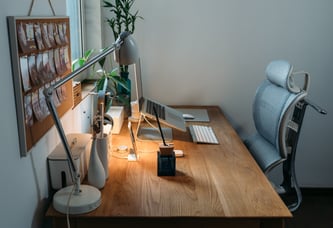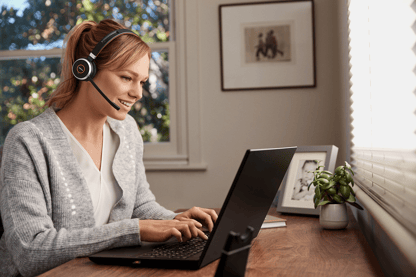 If you’re about to start working from home, you may be wondering how best to go about it.
If you’re about to start working from home, you may be wondering how best to go about it.
Working flexibly at home can be a great way to get things done, but if you don’t set a few ground rules, for yourself and others, your efficiency can soon drop.
To build your perfect work at home environment you will need to:
- Own your workspace
You need a dedicated workspace with an adjustable chair that supports your lower back.
Healthy working means sitting at a desk or table with your laptop or desktop PC and accessories in easy reach.
Your eyes should be level with the top of your monitor screen. You may need to use a laptop riser with separate keyboard to achieve this, or a monitor riser if you’re working on a desktop PC. If you usually have these accessories at work, find out if you can take them home or buy a separate set.
 Other items you can use to prevent musculoskeletal injuries include footrests and wrist rests. If you’re likely to be working from home for some time, these will be vital to your healthy working.
Other items you can use to prevent musculoskeletal injuries include footrests and wrist rests. If you’re likely to be working from home for some time, these will be vital to your healthy working.
If you use screens as part of your daily work, your employer should do a display screen equipment (DSE) workstation assessment. This needs to cover your whole workspace, including equipment, furniture and work conditions.
Your employer should do this whenever a new workstation is set up, or a change is made to an existing workstation. If your home working arrangement is a new one, you will need this assessment.
Read our blog about how to organise your home office with Fellowes here.
- Get into the zone
Try to approach the start of each day as if you were going to your workplace.
It’s a good idea to get dressed and go outside for some fresh air or walk around your garden before ‘arriving’ at your home office.
Whatever helps you to prepare mentally will help you tackle the day better.
- Prevent interruptions
You will need to be clear to others that you are working, even though you’re at home.
If any family members are at home during the day, tell them that you are ‘at work’ and won’t be able to socialise until you’re finished. It is also a good idea to let your home phone go to answer machine until the end of the day.
If you need to put a notice on your office door or designate your workspace as no entry during your work hours, so be it.
- Power your day with tech
Technology apps make remote working much easier. Your organisation may already use tools like Slack, Trello or Google Docs. These are useful for keeping in touch with colleagues and for on-going work updates.
For chat and video conferences, Windows 10 with full Microsoft Teams integration can help you to collaborate and share work with people anywhere. This comes with a shared workspace for conversations, files and third-party services.
If you make phone calls at work, you need a headset. This will help to protect your neck by helping you sit or stand in a natural position on the phone, rather than cradle a receiver between your ear and shoulder.

Visit out technology website to view our product range https://www.BannerTechnology.co.uk/
-
Rest breaks
Being at home doesn’t mean you should work straight through. You need to take the same regular breaks that you would at work.
Your eyes need regular breaks from the screen and your body needs you to get up and walk around, for the sake of your health. You should be standing up and walking somewhere, whether that’s the kitchen or the bathroom, throughout your working day.
If you can take time to go for a quick walk around the block, or run around your garden at lunchtime, you’ll also feel more alert and productive in the afternoon.
With Banner you can make working from home a success. We offer products across a range of price points to suit your budget. Simply call your account manager, phone us on 0843 538 3311 or to become a customer email contact.us@BannerUK.com.
Join us on LinkedIn or follow us on Twitter. Or subscribe to our blog for notifications on our latest articles by adding your email to the subscribe box at the top of this page.

